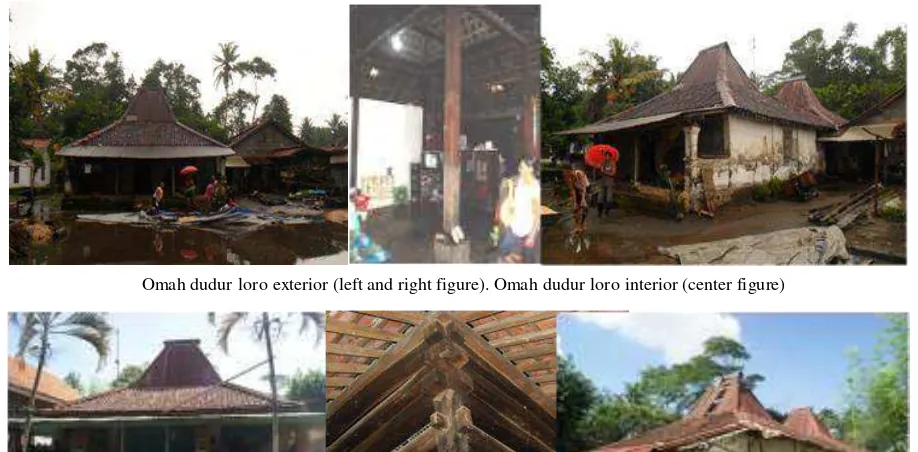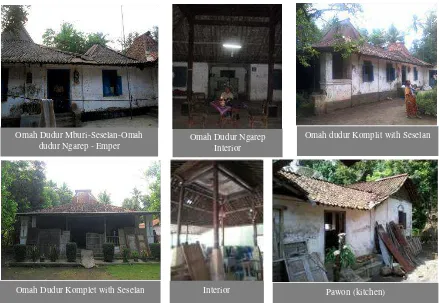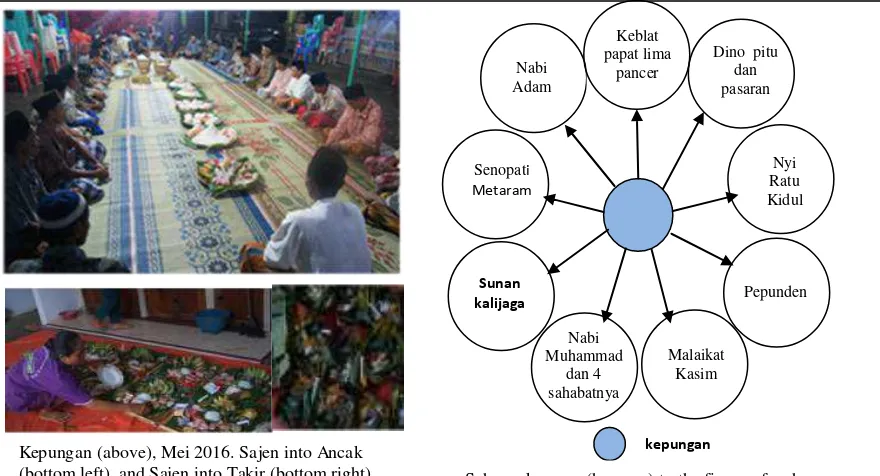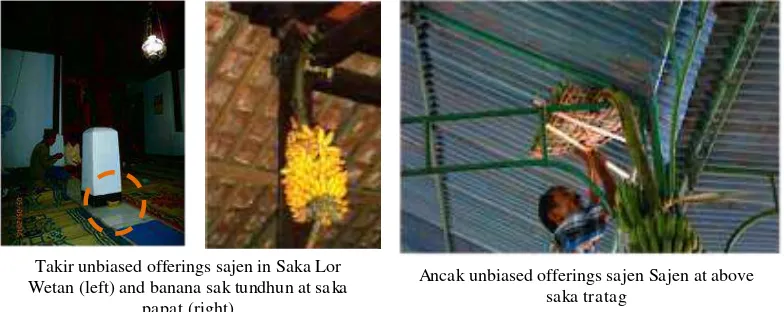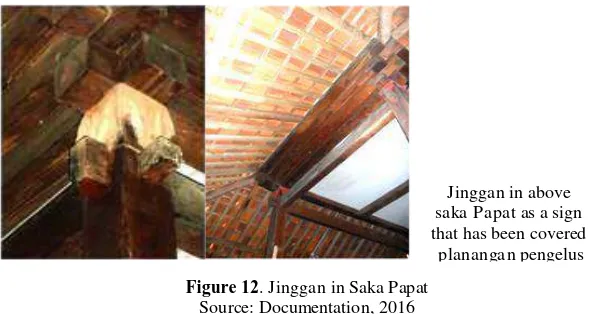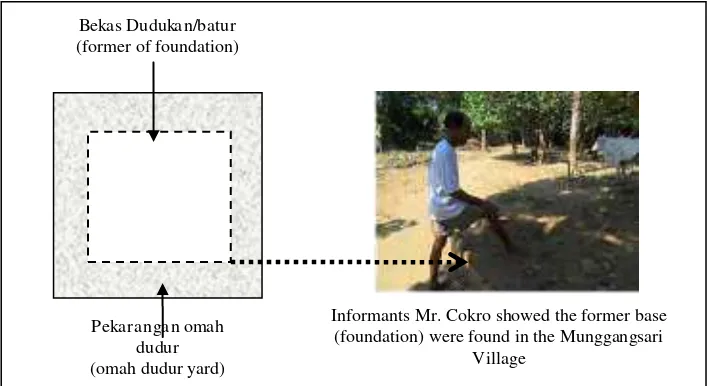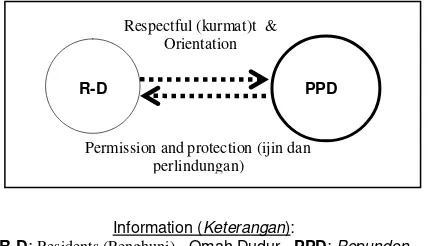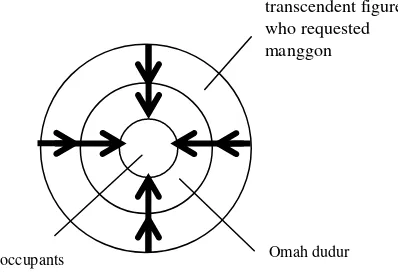TRANSCENDENTAL IN OMAH DUDUR
Satrio HB Wibowo1,2, Sudaryono3, E.Pradipto4
1
Lecturer, Program Study of Architecture, Universitas Widya Mataram Yogyakarta, INDONESIA
2Student, Departement of Architecture and Planning, Universitas Gadjah Mada, INDONESIA, [email protected] 3
Lecturer, Departement of Architecture and Planning, Universitas Gadjah Madas, INDONESIA, [email protected]
4
Lecturer, Departement of Architecture and Planning, Universitas Gadjah Mada, INDONESIA, [email protected]
ABSTRACT
Omah dudur is a typical dwelling tribal of Java communities at Urut Sewu, Java Region, Purworejo, Central Java, Indonesia; which is located extending from the border of Yogyakarta-Purworejo of Central Java in the East to the district of Kebumen, Central Java in the West. In its habitat, omah dudur partakes the highest degree than the other two types of residential groups, i.e., Srotong and Limasan. The high degree of omah dudur is measuredby two things. First, to build omah dudur requires high cost. Second, omah dudurposseses transcendental value. Omah dudur has transcendental value which is represented in the form of karibawan (commanding) to bring salvation, adem ayem to bring happiness, and sandang pangan to provide enough food and clothing for the residents. The main transcendental value of omah dudur is revealed through manggon; which then becomes pepunden of the Queen of the South and Sunan Walisanga as the trustees of omah dudur and its inhabitants. Architecturally, transcendental value attached to omah dudur, forms a distinctive and authoritative spirits. To uncover the transcendental value of omad dudur the paradigm of phenomenology of Husserl (1965) coupled with naturalistic method of Lincoln and Guba (1985) were used. It is expected that the disclosure of omah dudur transcendental value will provide local wisdom of Javanese architecture.
Keywords: transcendental, omah dudur, revelation, Java architecture
ABSTRAK
Omah dudur adalah hunian khas masyarakat suku Jawa di Wilayah Urut Sewu, Kabupaten Purworejo, Jawa Tengah, Indonesia; terletak memanjang mulai dari perbatasan Yogyakarta -Purworejo Jawa tengah di sisi Timur sampai kabupaten Kebumen, Jawa Tengah di bagian Barat. Di dalam habitatnya, omah dudur memiliki derajat tertinggi dibandingkan dengan dua jenis hunian lainnya srotong dan limasan. Derajat tinggi omah dudur diukur berdasakan dua hal; pertama, tingginya biaya yang dibutuhkan untuk mendirikannya. Kedua, adanya nilai transendental dalam omah dudur. Nilai transendental itulah yang menjadikan dan membentuk omah dudur memiliki karibawan (wibawa) dan membawa keselamatan, adem ayem dan sandang pangan bagi penghuninya. Sumber utama dari nilai transendental omah dudur tersebut berupa wahyu yang manggon di omah dudur. Wahyu dalam hal ini adalah berupa roh halus yang diundang untuk manggon di omah dudur dan roh halus yang sudah ada di omah dudur dan pekarangannya yang harus dihindari penghuni. Profil wahyu tersebut adalah pepunden, ratu Kidul dan Sunan Kalijaga beserta sunan walisanga yang menjadi wali bagi omah dudur maupun penghuninya; sedangkan profil wahyu yang diharus dihindari adalah sengkala.Fenomena omah dudur yang penuh nilai transendel, kiranya belum menjadi perhatian para peneliti bidang arsitektur sehingga keberadaannya masih tersembunyi hingga kini. Upaya penting yang harus dilakukan adalah dengan mengeksplor dan mengungkap omah dudur dan nilai transendentalnya; dan untuk mengungkapnya digunakan paradigma Fenomenologi Husserl (1965) dengan metode Naturalistik dari Lincoln dan Guba (1985). Diharapkan pengungkapan transendental omah dudur ini dapat mengangkat pengetahuan omah dudur yang tersembunyi menjadi ilmu pengetahuan dalam arsitektur Jawa.
Kata kunci: transendental, omah dudur, wahyu, arsitektur Jawa.
1.
INTRODUCTION
2) omah dudur siji-limasan; 3) omah dudur loro; 4) omah dudur komplit; and 5) omah dudur komplit-seselan (Satrio HB et al, 2016). Based on several references, omah dudur forms classified in Javanese architecture with a shape similar to joglo lawakan (Dakung, S. et al. 1986/1987; p. 52) and joglo jompongan (Slamet DS, 1981/1982; h.63; R. Ismunandar, K, 1993; p. 94) with a large size, so it requires a lot of wood and expensive to built. Second, the transcendental Values is what makes and formed omah dudur have karibawan (authority) to bring salvation, adem ayem (happy) and cekap sandang pangan (enough clothing and food) for the residents. Transcendental values on omah dudur that will be focused in this study; the goal is to be able to understand and accept the embodiment of transcendental in omah dudur.
This study is important, because the empirical exploration of the architecture of Java is still very minimal, so there are many layers of traditional Javanese architecture that remain hidden and untapped; and thus also in the context of the transcendent. Of the various libraries, transcendental disclosure in omah jawa (java house) very prominent is the presence of the goddess Dewi Sri that are in the senthong tengah (center room) (Dakung, S. et al. 1986/1987; p. 63). It is unfortunate that in the end there generalize the findings; ie assume that the whole omah Jawa in the Java architecture and in any Java region certainly has confidence Dewi Sri as the goddess of fertility. The generalization is unclear, because not all regions have it
Omah Dudur inhabited by Petani (farmers) and Gentho/Bajingan (Rogues)/ Gentho (Wibowo, Satrio HB et al, 2016) in the village Munggangsari be the absence of empirical evidence transcendental value in the form of Dewi Sri;but has a typical personification Munggangsari village known as wahyu (revelation). Wahyu is what makes omah dudur have the strength and spirit called for by the community as karibawan (authoritative). This wahyu (revelation) is precisely what makes people have the hope for keselametan (salvation), adem ayem (happy) and cekap sandang pangan (enough clothing and food). Wahyu also makes people respect and appreciate omah dudur as an pusaka (heirloom) that has a high degree.
2.
METHODOLOGY
This study uses a qualitative method especially Naturalistic Paradigm according Lincol and Guba, 1985. The substance of this method are: 1) The study was conducted through interviews and direct observation in the field in depth by researchers and without a theory. There are two stages in the exploration field which stage the grand tour at the beginning of the study and a mini tour to deepen the findings (Wibowo, Satrio H.B, et al, 2016); 2) this study to reveal tacit knowledge; 3) needed local residents as respondents / informants to help dig the required data; and 4) analysis performed directly when researchers in the field. In the analysis phase Lincoln and Guba, 1985 using constant comparative analysis by Glasser and Strauss (1967). The substance of constant comparative analysis passed through four stages; the first is to compare the information unit to obtain a category. The second is to integrate the categories along with its properties; The third and fourth restriction theory is a theory of writing.
3.
DISCUSSION
3.1
. Omah Dudur Type
There are five types of omah dudur. The first type is omah dudur siji. Omah dudur siji is omah dudur having a one omah dudur. In substantive, omah dudur siji formed by a unitary wood frame and wall covering saka papat with accessories in the form umpak (pedestals) , insen/tumpang, jahit , dedel, ontop, and cantel. Unity of a wooden frame with the wall, supporting roof frame includes duduran makutho, duduran biasa, sunan, sentheng, and usuk at the top. At the bottom of the roof frame is supported by a blandar (beam) that is in the top of the wall surrounding the omah.
When seen from the outside, then the formation omah dudur described above will form the unity of the roof called the gunungan (roof) and the wall. The gunungan is divided into two but both remain united; at the top of the truncated pyramid shape with a small size called makutha and bottom of the pyramid-shaped widened called emper (overhang). In the bottom of the mountain, there is a surround wall with gebyok on the front for out access, and a door, a window on the right and left omah. At the front of the house there is an emper that is fused together with the gunungan; The emper shaded space underneath is called as a teras (terrace). On the terrace is much to use the fence as a barrier.
Figure 1. Omah Dudur Siji Source: Documentation, 2016
The second type of omah dudur is omah dudur siji with limasan. Omah dudur siji with limasan is omah dudur amounted to one coupled with a limasan on the front dudur. Limasan always been at the front of omah dudur to function as a terrace. As in omah dudur siji, this omah dudur also serves to dwelling. Likewise for its architectural form, has similarities with omah dudur siji described before; while the architectural form of a limasan formed because house basic shape that extends. The basic shape of the omah dudur formation of the one gunungan (the roof) pyramid-shaped elongated without makutha. On the front and back of the gunungan there is a wide emper; while on the left and the right found a very short emper. The limasan roof is supported by saka numbered 8 and the walls that surround the omah. Just as dudur siji which has a terrace, as well as a limasan has a terrace front section.
Figure 2. Omah Dudur Siji with Limasan Source: Documentation, 2016
The third type of omah budur is omah dudur loro. Omah dudur loro are also known as satrio tanding or satrio sak kembaran (twin roof); both omah dudur is lined from back to front. Omah dudur front section is called omah ngarep or balean and and the back is called omah buri. The function of omah dudur mburi as a family room with spaces that includes jerambah (family room) and senthong (bedroom); omah dudur ngarep while there is only one large room that the function for living room. Both omah dudur continuous and connected by doors gebyok models exactly in the middle; on the left and right of the door is usually in the form of a brick wall. In one gebyok doors, there were five door openings with nangka wood material
In substantive, omah dudur loro has the same architectural forms with omah dudur siji namely the unity of the gunungan that is supported by saka papat in the middle and the wall around omah. The house is also equipped srotong with function pawon conveniently lined (left or right omah mburi) with omah dudur buri; while the wells are behind pawon. There is also an emper in front of the omah dudur ngarep to the terracealong the with omah dudur ngarep. On the emper, the front fence is often found either of wood or brick; however, also found an emper completely without the fence.
Srotong kitchen function
Omah dudur to dwelling function
Makutho
Emper
The limasan in front omah
dudur The omah dudur behind
limasan Saka Papat (main pillar) Saka Papat (main pillar) Dedel
Tumpang
Jahit
Umpak / Saka papat (main pillar)
Figure 3. Omah Dudur loro
Source: Documentation, 2016
Type of omah dudur fourth is omah dudur komplit. Omah dudur complit is omah dudur loro added with a limasan on the front. Architecturally, both omah dudur (mburi/back and ngarep/front) have the same with omah dudur loro described before; as well as the limasan has a shape similar to a limasan arsitektural on omah dudur siji added limasan. In terms of function, both dudur has the same function with omah dudur loro, just the living room on dudur komplit more extensive because a limasan on the front has the same function with balean. Omah dudur komplit also has srotong for pawon is located lined with omah buri (left or right omah mburi) and wells (wells, bath room, wc) behind pawon.
Figure 4. Omah dudur komplit Source: Documentation, 2016
Omah dudur type the last (fifth) is omah dudur complete with seselan. In substantive, omah dudur komplit with seselan equal to omah dudur komplit, only diseseli or added omah kampung in the middle between two dudur. With so then there is a row of houses from back to front is dudur-seselan kampung-dudur- limasan or emper. The form of seselan kampung are other forms of the village in general. Seselan kampung shape in Munggangsari village and in the surrounding villages Urut Sewu, similar to a limasan just is not equipped with a emper ngarep dan emper mburi. This seselan kampung serves as senthong, devoted to guests who stay. Other
Omah dudur loro exterior (left and right figure). Omah dudur loro interior (center figure)
Omah dudur loro exterior (left and right figure). Insen/tumpang construction in omah dudur interior (center figure)
A
functions for dudur and limasan / emper in omah dudur komplit with seselan have the same type which have been described before.
Figure 5. Omah Dudur Komplet with Seselan Source: Documentation, 2015
3.2. Transcendental In The Munggangsari Village.
In the paradigm of phenomenology of Husserl (1965), the transcendental truth is one of the truths of the three truths that he believes; two more truth is the truth intentionality and physically. Transcendental truth is the truth which is before the other two for spiritual truth. Spirituality is then received, transformed into intentional; and of intentionality transformed into physical goods that can be perceived by the five senses.
In the village of Munggangsari believed wahyu (revelation) in the form of a spiritual figure of nine; they are the Prophet Adam, keblat papat lima pancer, dino Pitu and pasaran, malaikat Kasim (Kasim angel), the prophet Muhammad and four companions, Panembahan senopati (King) ing mataram, Nyi Ratu Kidul (Queen of South Sea), Sunan Kalijaga, and Pepunden. Spiritual figures are always mentioned in the prayers at the ceremony of kepungan as kurmat (respectful). Of the nine spiritual figure, the figure pepunden a spiritual being who most closely and directly related to rural communities. From the testimony of informants, the name of the Munggangsari village pepunden named mbok nyi mas or mbok mas; physically pepunden shaped village similar large tree on the Daendeles roadside in the Munggangsari village area.
Spiritually, pepunden have power and authority over the lives of villages, including against omah dudur. This can be seen with a large variety of activities village-scale such as Saparan and rejeban aiming to exalt and give kurmat for pepunden. It thus do well in the activities of individual communities as mantenan, supitan, adeg-adeg omah (build a house). Of all the actions kurmat, the main goal is to get to keselamatan (safety), adem ayem (happy) and cekap sandang pangan (enough clothing and food). How that is done to make the process kurmat is the kepungan ceremony (Wibowo, Satrio HB et al, 2016; pp. 308-316). The kepungan is the ritual prayer the residents with various small and large uborampe tumpeng form, followed by the manufacture of sajen in 12 pieces in ancak and takir (12 Takir). For 12 ancak and takir placed in 12 places in the house. From the kepungan procession by kurmat (respectfully) to nine spiritual figure (revelation), here in after shall be taken of the one ancak sajen to be presented to pepundhen. The offerings to pepunden the village is done through kuncen and placed in pasucen (offerings room); pasucen itself is at home‘s kuncen.
Omah Dudur Mburi-Seselan-Omah
dudur Ngarep - Emper Omah Dudur Ngarep Interior
Omah dudur Komplit with Seselan
Figure 6. Offering Scheme to Pepunden Source: Observation and Interview, 2016
From the information the various respondents note that to date, the public has never happened does not heed the kurmat to a spiritual being through the kepungan. This happens due to confidence in the community is so strong that it will happen sengkala (dangerous) when did not kepungan. Informed that their lack some sajen course, as has happened in neighboring villages may result sengkala. As happened in the Patutrejo village, due to lack sajen that must be provided then the food reserves disappear so suddenly that the custom event into chaos.
Figure 7. Kepungan, Sajen and Scheme kurmat to figure Spiritual Source: Observation and Interview, 2016
3.3. Transcendental In Omah Dudur
Related to omah dudur, there is a wahyu with four main figure, they are Sunan Kalijaga, Pepunden, sunan Walisongo and Nyi Ratu Kidul. Pepunden and Nyi Ratu Kidul are a figure wahyu that his position is outside omah dudur, while sunan Walisongo and sunan Kalijaga manggon (stay) position in omah dudur. Not with standing the fourth position in the hierarchy are not interconnected, but each stands alone as a highly dikurmat and worshiped by the inhabitants of omah dudur the same way through the kepungan, etang jawi and giving
Saparan Scheme offerings and activities of individual communities to Pepunden mBok Mas
kepungan
Scheme kurman (homage) to the figure ofwahyu Kepungan (above), Mei 2016. Sajen into Ancak
(bottom left) and Sajen into Takir (bottom right)
The figure of the first wahyu in omah budur is Sunan Kalijaga. In the omah dudur, transcendent figure Sunan Kalijaga occupying at saka Lor Wetan (East North). In the important events such as mantenan, sunatan then saka Lor Wetan and others are always given sajen pisang (banana) sak tundhun di Sakanya and sajen housed in a ancak or Takir. The importance Saka papat and in particular saka saka Lor Wetan on omah dudur which has a transcendental value high in the village, due to the derivative of the work of Sunan Kalijaga Demak especially against the great mosque at saka Lor Wetan. Disclosed that the Sunan Walisanga make great mosque Demak; while making saka papat, Sunan Kalijaga got a part to make saka Lor Wetan. When Sunan-sunan works completed three other saka (pillars), Sunan Kalijaga trouble doing it, because of the difficulty looking wooden. It is said that every cut wood around Purworejo, the wood cut down always disappears and repeated so. Eventually returned to Demak Sunan Kalijaga to collect shavings (yield wood shavings) from the other Sunan to be formed and used as saka lor wetan which have the same power with the other saka.
Figure 8. Saka Lor Wetan Source: Observation dan Interview, 2016
People in the village and surrounding Munggangsari trust and believe in the transcendent value in saka lor wetan because the work force because of Sunan Kalijaga who create saka lor Wetan with knowledge and strength beyond his own strength. Therefore saka lor wetan be special in this village, because it is believed to have spiritual powers that can provide mental and physical strength to the residents. Besides that, the specific treatment of saka lor wetan, also showed kurmat to Sunan Kalijaga as creator saka lor wetan done spiritually.
Figure 9. Saka Lor Wetan and Sajen in Saka; Source: Dokumentation, 2016
The figure of the second wahyu in omah dudur is Sunan Walisongo. Sunan walisanga is Wali (Guardian) propagator of Islam in Java, they are amounting to nine people; the ninth Sunan are Sunan Kalijaga, Sunan Bonang, Sunan Muria, Gunungjati Sunan, Sunan Giri, Sunan Kudus, Sunan Ampel, Sunan Drajat and Sunan Gresik (Maulana Malik Ibrahim). Transcendentally, nine sunan believed manggon (occupy) in the gunungan (dudur roof) in the eight corners dudur and one in Sunan (molo) as leader. Of information respondent, sunan Walisongo is in the gunungan started when the ritual of kepungan and etung jawi in build omah dudur. Solicited or not, the prayers of the kepungan and petungan bring the Sunan to manggon in the gunungan. Sunan Walisanga existence in the gunungan of omah dudur as believed by Munggangsari villagers, show that omah dudur and its inhabitants have a guardian; in other words omah dudur and occupants diwaleni by sunan.
Saka lor wetan Saka lor wetan
LOR
Takir unbiased offerings sajen in Saka Lor Wetan (left) and banana saktundhun at saka
papat (right)
Diwaleni implies that spiritually, omah dudur occupants had parents who provide protection, security, and at the karibawan (authority). The meaning as that's what many perceived by Munggangsari villagers that omah dudur is alive, authoritative, and medeni (scary). Physically, the gunungan not only provide protection to the occupants from heat and rain, but the form of omah with unity gunungan, saka papat, tumpang, pedestal, saka goco, wall and other omah dudur elements considered to provide more value on the aesthetic. Therefore it is proven that the conditions in the Munggangsari village and surrounding, omah dudur occupied the highest degree compared with other omah like a limasan and srotong.
Figure 10. Placement Sunan Wali Sanga in Gunungan Omah Dudur Source: Scheme dan Dokumentasi, 2015-2016
The third wahyu figure at omah dudur is Nyi Ratu Kidul (The Queen of South Sea). Spiritually, Munggangsari village areas and villages around Urut Sewu is a region of South sea kingdom with her Queen is Kencana Wungu. As part of the kingdom of the South Sea, then respect for the kingdom became obligation for the whole village. Atribute to the Nyi Ratu Kidul is done spiritually and physically. Spiritually, homage is done by always calling Nyi Ratu Kidul in Kaum (intercessors) prayers, in various traditional events. Respect is physically associated with omah dudur is done by directing omah dudur towards the South which the Kingdom of the South Sea there it. Until now the direction omah dudur South to still be awareness to society, although there were started to change its orientation towards road. For omah dudur fixed at South orientation, it will look a lot at omah dudur that backs the streets of the village.
Omah dudur site in the dusun Munggangsari 3 which shows the direction toward the South (left figure). Omah dudur example direction south and back to the village road (right figur)
Figure 11. Omah Dudur orientation to the South; Source: Observations and Documentation, 2016
The fourth figure of the wahyu (revelations) in the omah dudur is pepunden. The relationship transcendent between omah dudur and pepunden occur in the prayers and offerings sajen especially in process-adeg adeg omah dudur (omah dudur construction). In the past the process adeg-adeg omah dudur always done kepungan began on batur (foundation), the constructions of saka papat (main pillars), beam, payon (roof) and others until finish adeg-adeg omah dudur. Currently, the process of kepungan in adeg-adeg omah dudur been summarized into two parts, namely the kepungan of the start and completion of adeg omah dudur. Kepungan for adeg-adeg omah dudur same as the kepungan that has been described before in the form kurmat with the mention mbok Mas/Nyi Mas in prayer and offerings sajen in the ancak to mbok Mas/Nyi Mas through pesucen (sanctuary).
Sunan Sunan
Sunan
Sunan Sunan
Sunan
Sunan leader inmolo
Sunan
Sunan Sunan Sunan
Sunan Sunan
Sunan Leader
Transcendental figure in omah dudur other than that described in the foreground is the pengelus (spirits) who do not have specific names as described by the informant. Additional information from informants is pengelus in omah dudur. Pengelus is of big men who do not clothes so that looks pelanangan (penis) which kawer-kawer. Meeting with the naked pengelus provide guidance to the public to cover planangan pengelus with fabric is named jinggan. The presence of these pengelus hints that omah dudur where pengelus being is interpreted as omah lanang (man house). Behind omah lanang is called omah wedok (woman house).
Figure 12. Jinggan in Saka Papat Source: Documentation, 2016
Found also pengelus bring sengkala (dangerous) for omah dudur residents. Found also pengelus bring sengkala (dangerous) for omah dudur residents. Pengelus are located in pusering pekarangan (center the yard) and on the batur (foundation) pent house and left behind when the house was broken down Facing such a dangerous pengelus and that residents are not affected sengkala then used two measures to deal with it is to avoid it and get rid of. Avoiding sengkala is done by putting omah dudur not be in pusering pekarangan. According to the villagers Munggangsari experience, such action is considered safe and not found sengkala disorders.
Technically, it found a way to avoid omah dudur not be in pusering pekarangan. The trick is to make the boundary line 1-5 badan (bodies) from the west side and rear yard. With so found a new size for the establishment omah dudur in yard. The new size yard diagonal line drawn further to get the midpoint for placement omah dudur. The central point is secure and was not in the middle of the courtyard originally as a place sengkala.
Figure 13. Sengkala Layout and the Omah Dudur Rules Not Allow In Pusering Pekarangan; Source: In the scheme of Informants, 2016
Jinggan in above saka Papat as a sign that has been covered
planangan pengelus
Pusering pekarangan (left of figure), Omah dudur should not be in Pusering pekarangan (center of figure), Omah dudur must be outsidethe Pusering pekarangan (right of gigure)
Pusering pekarangan:
Figure 14. Placement Technique Omah Dudur in Outside pusering pekarangan Source:In the scheme of Informants, 2016
The second act is penyingkiran; penyingkiran technique is done by cleaning. Things that need to be cleared in this case is the former foundation omah dudur. Sometimes Blandong (architec of javanese) and the owner of the yard does not know that there is a former foundation omah dudur has buried along time. From the information the respondents have known that former foundation can bring a very dangerous sengkala ranging from illness to death for residents and their families. On this basis, conducted a purge of former batur omah dudur so the place was feasible to build omah dudur.
Figure 15. Former batur (foundation) Omah Dudur Source: Documentation, 2015
4. CONCLUSION
From the description that has been described, it can be inferred the existence of a transcendental in omah dudur Munggangsari village, Grabag district, Purworejo regency, Central Java, Indonesia. Transcendental omah dudur characteristics: 1) the transcendental is happening inside and outside omah dudur; and 2) the figure of wahyu (revelation) requested manggon and that is not acceptable. According to the research, the transcendental in omah dudur greatly affect the lives of the occupants and omah dudur characteristics.
Conclusion 1: Transcendental happens inside and outside omah dudur
Transcendental happens inside omah dudur is transcendent relationship between the figure of wahyu is Sunan Kalijaga, Sunan Walisongo and Pengelus with omah dudur and occupants. Transcendental relationship that occurs is done consciously and hereditary to invite pengelus to manggon in omah dudur. The purpose of it all is that omah dudur have karibawan and high degree; while the occupants hope of such transcendent figures to
Garis bantu
1 – 5 badan
Omah dudur tidak lagi di pusering
Pekarangan rumah
1 – 5 badan
Pusering pekarangan
Garis bantu Help lines
House yard
Center of yard
Omah dudur is no longer in the Pusering pekarangan
Pekarangan omah dudur (omah dudur yard) Bekas Dudukan/batur (former of foundation)
Informants Mr. Cokro showed the former base (foundation) were found in the Munggangsari
give karibawan (authority), keslametan (safety) adem ayem (happiness) and cekap sandang pangan (enough clothes and foods).
Transcendental happens outside omah dudur is transcendent relationship between omah dudur with Pepunden and with Nyi Ratu Kidul (Queen of the South); both are outside omah dudur. Pepunden located in the Munggangsari village and Nyi Ratu Kidul is located in South Beach. Omah dudur relationship with Pepunden obtained when adeg-adeg omah dudur (build omah dudur) for purpose of providing kurmat and permission to start building omah dudur.
Figure 16. Transcendent Relationship scheme Between Residents - omah dudur with Pepunden Nyi Mas/mBok Mas
Omah dudur relationship with Nyi Ratu Kidul are marked with omah dudur orientation facing direction Nyi Ratu Kidul (Queen of the South) or South direction orientation. The goal is a sign kurmat (respectful) to Nyi Ratu Kidul.
Figure 17. Transcendent Relationship scheme Between Residents - Omah Dudur
With Nyi Ratu Kidul
Conclusion 2: The figure of wahyu (revelation) requested manggon and that is not acceptable in omah dudur.
The figure of wahyu requested manggon in omah dudur is Sunan Kalijaga at saka papat especially saka lor wetan and sunan Walisanga on the gunungan (roofs) and pengelus male figure symbolized by jinggan cloth at the end saka papat. The existence of the figure of Sunan Kalijaga at saka Lor Wetan is become factor of strength for the occupants so they have karibawan (authority). Sunan Walisanga a transcendent figure become trustee for omah dudur and the occupants, so has the rulling (power) over residents and omah dudur. This condition makes the occupant to be safe, adem ayem (happinese) and cekap sandang pangan (enough clothes and food), while for omah dudur, making omah dudur as omah whose character karibawan (authoritative) and medeni as well as a high degree.
Respectful (kurmat)t & Orientation
Permission and protection (ijin dan perlindungan)
PPD R-D
Information (Keterangan):
R-D: Residents (Penghuni) - Omah Dudur. PPD: Pepunden
Spiritual relationship (Hubungan spiritual)
Spiritual relationship (Hubungan spiritual)
Respectful (Kurmat)
direction orientation
NRK R
D
Information :
R: Residents (Penghuni). D: Omah Dudur. NRK: Nyi Ratu Kidul
Spirituality Relationship
Another wahyu that manggon (occupy) in omah dudur are big men who symbolized in the jinggan form at the top end saka papat. Jinggan is a pink cloth, a symbol cloth cover planangan (male genitalia); and therefore omah dudur where wahyu (revelation) is located (omah dudur ngarep) called omah lanang.
Figure 18. Schematic figure of Transcendent (wahyu/Revelation) who manggon on the omah dudur and its relationship with omah dudur dudur and occupants
The figure of wahyu that are not accepted in omah dudur is a figure that is referred to as sengkala is dangerous and influential figure large toward the lives of the occupants omah dudur. The figure is in pusering pekarangan (center of yard) and in the former foundation omah dudur. Strategy occupants in the face of the transcendent figure is to avoid and clean up with certain rules. These are: 1) putting omah dudur not be in the pusering pekarangan; and 2) dispose former the batur (foundation). The purpose of it all is that the occupants survived, not expossed sengkala.
ACKNOWLEDGEMENT
Special appreciation is for the Lord Jesus, Savior of the world, because its leaders so that the process of research and writing of this can work well. To Prof. Sudaryono and DR. E. Pradipto say thank you for guidance. Say thanks also to Mr. Cokro Wiyono, Mr. Bayan Misro, Mr. Dalang Tunggana and villagers Munggangsari, Grabag, Purworejo regency, Indonesia who was willing to become informants. Do not forget to say thank you to the University of Trisakti which has given place to a seminar. To the architecture students of the University Widya Mataram Yogyakarta who also helped research, say thank you. I believe that the ladies and gentlemen who have supported this research will be blessed of the Lord Jesus.
REFERENCES
1) Glaser, B.G dan Strauss. A.L. 1967. The Discovery of Grounded Theory, Strategies for Qualitative Research. Aldine Publishing Company, Chicago.
2) Husserl, E. 1965. Phenomenology And The Crisis Of Philosophy. English translation copyrigh by Quentin Lauer, Harper & Row, Publisher, Incorporated, New York.
3) Ismunandar. (1993). Joglo Arsitektur Rumah Tradisional Jawa (Keempat). Semarang: Dahara Prizel. 4) P.M. Laksono. 1985. Tradisi Dalam Struktur Masyarakat Jawa Kerajaan Dan Pedesaan. Yogyakarta:
Gadjah Mada Universty Press.
5) Reksodihardjo, Sugeng, Imam, Sudibyo, Soetomo, WE, Abu, Rofai, Dakung, Sugiarto. 1981/1982. Arsitektur Tradisional Daerah Jawa Tengah. Departemen Pendidikan dan Kebudayaan Direktorat Jenderal Kebudayaan Direktorat Sejarah dan Nilai Tradisional Proyek Inventarisasi dan Dokumentasi Kebudayaan Daerah Jawa Tengah, Semarang.
6) Wibowo, H. J., Murniatmo, G., & Dh., S. (1986). Arsitektur Tradisional Daerah Istimewa Yogyakarta. (S. Dakung, Ed.). Yogyakarta: Departemen Pendidikan dan Kebudayaan Proyek Inventarisasi dan Dokumentasi Kebudayaan Daerah.
7) Wibowo, Satrio. H. B., Sudaryono, & E.Pradipto. (2016). Dudur-Fenomena Omah Lurah Geng. In Forum Diskusi Metode Penelitian Disertasi Arsitektur 4 Kualitatif Kuantitatif (pp. 79–89). Yogyakarta: Program Doktor Arsitektur-Sekolah Pasca Sarjana Universitas Katolik Parahyangan Bandung dan Program Pasca Sarjana Universitas Atma Jaya Yogyakarta.
8) Wibowo, Satrio H.B., Sudaryono, & E.Pradipto. (2016). Omah Dudur In Urut Sewu Region, Grabag, Purworejo, Indonesia. “Inclusive Space, Enriching Culture” 3rd Biennale ICIAP 2016 International
transcendent figure whorequested manggon
Conference on Indonesian Architecture and Planning (pp. 308–316). Yogyakarta: Department of Architecture and Planning Faculty of Engineering Gadjah Mada University.

